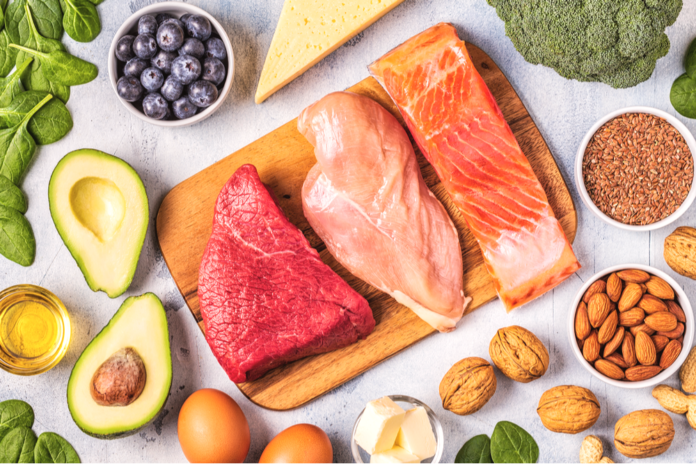It’s been claimed that the effort to achieve leanness is essentially a game of nutrient partitioning. Also called energy partitioning, does this concept hold a scientific basis?
Allow this guide to answer the most burning questions including, what is nutrient partitioning and how is it achieved?
What Is Nutrient Partitioning?
A concept first introduced into the bodybuilding world by John Parillo, nutrient partitioning refers to how different nutrients are fated after being ingested. He aimed to explain why certain foods preferentially build muscle while others promote fat accumulation and storage.
It relies on the premise that healthy versus unhealthy carbohydrates, fat, and protein to some extent affect body composition differently. In other words, nutrient partitioning opposes the concept that “a calorie is a calorie is a calorie,” and aims to show how eating certain foods at an optimal time contributes to building the quintessential bodybuilding physique.
Typical Fate of Macronutrients
To fully grasp nutrient partitioning, it’s vital to understand typical metabolism and fate of the three different macronutrients – carbs, fat, and protein.
When simple carbohydrates like processed and packaged food are consumed, the body will secrete insulin and either burn it as fuel or convert it into fat for storage. When fat is eaten, the body can use it as fuel via a slower mechanism than carbohydrates or store it in adipose tissue as well. Conversely, when protein is consumed, the body will utilize it to build, grow, and repair new muscle and tissue or store it as fat if there is an abundance.
However, the degree to which these processes happen depends on genetics, hormone balance and influences, meal timing, and most importantly, according to the nutrient partitioning concept, the quality of the macros. Nonetheless, the three main purposes of nutrient partitioning can be summarized as:
- Shuttle more protein calories to the muscle
- Store fewer calories in fat tissue
- Effectively utilize more calories for immediate and short-term energy needs
So how can this be accomplished?
The Science Behind Nutrient Partitioning
Partitioning nutrients to the correct location is best achieved through meal timing around exercise and via consuming quality, nutrient-dense foods that promote muscle growth and reduce fat storage. Yet, the science of nutrient partitioning relies on manipulating hormones to a large extent.
Exercise and Energy Partitioning
Exercise elicits chemical changes that affect the brain and muscle and fat tissue in important ways. First of all, exercise encourages nutrient partitioning by making muscle tissue more insulin sensitive compared to fat tissue.
Muscles are composed of protein and also store carbohydrates in the form of glucose, and the body partially breaks down this protein and utilizes the glucose as fuel during exercise. Hence the reason why it’s recommended that the post-workout meal consists of protein and carbohydrates to replenish these skeletal muscle stores.
Although insulin normally facilitates fat storage, exercise causes insulin to facilitate the storage of protein and carbohydrates back into muscles. This complex mechanism makes muscle tissue more insulin sensitive than fat tissue, so the muscles respond more to a less amount of insulin. Ultimately, this allows them to uptake the nutrients and calories from protein and carbs more efficiently and discourages fat storage.
Additionally, intense exercise causes the secretion of a special signaling molecule called interleukin-6 (IL-6). This secretion not only encourages the body to use stored fat molecules for fuel during exercise, but increased levels of this molecule in the brain after exercise lead the brain to direct calories consumed during the post-workout period to muscles and away from adipose tissue.
The above metabolic effects of exercise last for hours after completion of the workout and lead to long-term changes that enhance these consequences further. Thus, consistent exercise adequately partitions nutrients by encouraging a metabolic state where muscles essentially hog calories and fat tissue sacrifices its stored energy and is denied new calories.
Nutritional Quality and Energy Partitioning
Although exercise is the easiest way to partition nutrients, combining it with a tailored nutrition plan will only enhance results. Because certain nutrients tend to promote skeletal muscle tissue growth and others inhibit or reduce body fat storage, one can further maximize the effects by eating them at the most appropriate times.
Generally speaking, protein, essential fatty acids, and simple carbohydrates spur muscle growth while protein, complex carbs, fiber, and calcium reduce fat storage.
Nutrients That Promote Muscle Growth
Protein is the main structural component of muscle tissue and accounts for twenty percent of muscle mass. Muscle tissue can only grow with sufficient protein consumption, which is the only macronutrient that contains nitrogen.
Furthermore, while essential fatty acids (DHA and EPA) are frequently associated with brain and heart health, they also help increase insulin sensitivity without initiating insulin secretion. Double win. When sufficient and even high levels of essential fats are consumed, more of them are incorporated into cell membranes, making them more permeable and enabling nutrients to enter and exit more easily. Basically, essential fatty acids create more insulin-sensitive muscle tissue that “steals” nutrients from fat tissue.
Moving along to simple carbohydrates, it is generally recommended to limit simple carbohydrates in the diet because of the resulting spike in insulin and subsequent blood sugar crash. Plus, if the simple carbohydrates are not needed for energy, they will be transported to the liver for conversion to fat.
However, when the body needs quick energy, like after exercise to replenish muscle tissue energy stores, this process does not occur. Instead, when simple carbs are consumed within an hour after exercise when muscles are most insulin sensitive, the rapid release of insulin will shuttle the energy straight to the muscles.
Nutrients That Inhibit Fat Storage
Because of its nitrogen content, protein is not easy for the body to convert into stored fat. Instead, the body prefers to use protein to support muscles and other tissues that contain high amounts of protein. Additionally, research shows that protein is the most satiating macronutrient, so people tend to inadvertently get full faster, eat less and feel full longer. Eating less further discourages the storage of fat.
Although complex carbohydrates are broken down into glucose, the smallest and most usable form of carbohydrate just like their simple counterpart, they are digested and absorbed more slowly. The slower a macronutrient is digested, the less likely it is to be stored as fat. In fact, research shows that those who eat mostly complex carbohydrates found in fruits, vegetables, and whole grains tend to be leaner compared to those who eat a larger portion of simple carbs.
Most likely, the above point is also related to the fiber content in most complex carbohydrates. Fiber is an indigestible component of plant foods that steals stomach space, promotes satiation, and does not contribute any calories. It also slows the absorption of other nutrients, thus reducing fat storage because calories are more likely to be stored as fat when absorbed quickly.
Interestingly, while calcium is normally associated with bone health, research reveals the amount of calcium present in fat tissue regulates fat storage. The higher the calcium levels in fat cells, the less fat the tissue stores and vice versa. It is proposed that calcium achieves this by reducing the activity of the hormone calcitriol, which promotes fat storage.
Indeed, studies have shown that when those who regularly consume insufficient amounts of calcium increase their intake to the recommended amount of 1,300 mg per day, they have significant fat loss.
In Summary
Nutrient partitioning is a concept that promotes anabolism (growth) of muscle tissue and reduces the storage of fat, essentially through hormone manipulation.
Consistent exercise helps achieve this by making muscle tissue more insulin sensitive than fat tissue, encouraging nutrients consumed in the post-workout window to be shuttled into muscles rather than stored as fat. On the other hand, certain nutrients and types of those specific nutrients exert various hormonal changes that also achieve the intended outcome.
All-in-all, science does seem to support nutrient partitioning, and working with a qualified Registered Dietitian enhances the opportunity to execute it correctly.
References:
Parrillo Performance. www.parrilloperformance.com/nutrient-partitioning-meal-timing-hormone-manipulation/.
Pacific Health Laboratories. Energy Partitioning. TrainingPeaks. www.trainingpeaks.com/blog/energy-partitioning/.






